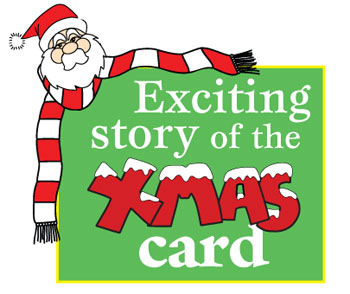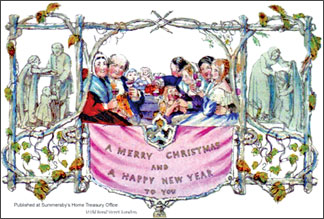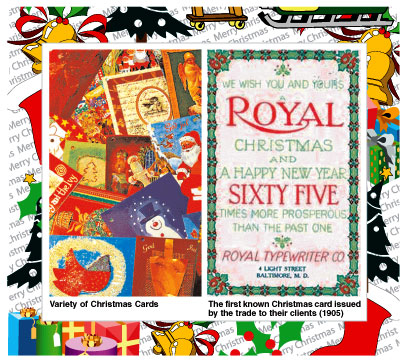

|

The world’s first commercially produced Christmas card, made by
Henry Cole |
Exciting story of the Xmas card
Lionel WIJESIRI
By now, you may have already begun to complain about having to sit
down and write out Christmas cards, but within your heart you know that
Christmas just wouldn't be the same without them. Christmas cards
typically end up as part of the Christmas décor, and add a personal
flair to a major Christmas gift.
Today Christmas cards can be purchased in bulk in nearly any
conceivable style. Everything from humorous and sincere to boisterous
and romantic, Christmas cards are the perfect avenue of telling those
you care for that you are thinking of them during the holiday season.
Just like all other holiday traditions, the Christmas card tradition
had to start somewhere sometime in the history. Do you have any idea?
Beginning
There are many contenders for the title of the world's first
Christmas card but it is generally accepted that the first one was
created in 1843 in England. It was commissioned by Sir Henry Cole, who
later became the first Director of the Victoria and Albert Museum. He
asked John Calcott Horsley, a member of the Royal Academy, to design a
card for him to send to his friends.
 |
The card was lithographically printed by Jobbins of Warwick Court,
Holborn, and each copy was hand-coloured by a professional artist named
William Mason. Lithography printed cards had been around since the late
1700's, a form of printing that involved creating the fine detail on
stone and then transferring it to paper, much like a stamp. The card was
issued from an art shop run by Joseph Cundall, a friend of Cole. Cundall
believed about 2050 copies would have been sold. The cards were
expensive items in those days, costing one shilling each, so Cole must
have intended to make something of this business opportunity, rather
than simply spend time on writing Christmas messages to his friends.
Cole's card wished the recipient 'A merry Christmas and a Happy New
Year to you'. It featured a family of three generations partaking of
good cheer (even the children) and toasting the absent friend - the
recipient. On either side were allegorical vignettes of charitable acts,
showing 'Clothing the Naked' and 'Feeding the Hungry'. The puritans
immediately denounced the card for its use of alcohol. Others found it
to be remarkably creative and a useful holiday greeting. And so, the
Christmas card was born.
Although it could not compete with the speed of email today, the
1800's nevertheless experienced a revolution in communication that
played an important role in creating the tradition of the Christmas
greeting card. Helped by the new railway system, the public postal
service made corresponding a popular past time. In England, people
recognized the advantage of a more efficient mail service and initiated
the practice of sending Christmas greeting cards to friends Wooden
engravings had been somewhat popular prior to the introduction of the
Christmas card, although they were expensive and time consuming
Types of cards
Christmas cards represent warm wishes and thoughts of peace towards
those we know and care for. While some people don't see the reasoning
behind the Christmas card tradition, most believe that Christmas cards
are a way of being inclusive to those whom we miss over the holidays.
Christmas cards are usually exchanged during the weeks before Christmas
Day by many people (including non-Christians) in Western society and in
Asia. The traditional greeting (as was in the first card itself) reads
"Merry Christmas and a Happy New Year".
There are innumerable variations on this greeting, many cards
expressing more religious sentiment, or containing a poem, prayer or
Biblical verse; others stay away from religion with an all-inclusive
"Season's greetings". The content of the design might relate directly to
the Christmas narrative with depictions of the Nativity of Jesus, or
have Christian symbols such as the Star of Bethlehem or a white dove
representing both the Holy Spirit and Peace.
Many Christmas cards are secular and show Christmas traditions such
as Santa Claus, objects associated with Christmas such as candles, holly
and baubles, and Christmastime activities such as shopping and partying,
or other aspects of the season such as the snow and wildlife of the
northern winter.
Some secular cards depict nostalgic scenes of the past such as
shoppers in 19th century streetscapes; others are humorous, particularly
in depicting the antics of Santa and his retinue. Early English cards
rarely showed winter or religious themes, instead favouring flowers,
fairies and other fanciful designs that reminded the recipient of the
approach of spring. Humorous and sentimental images of children and
animals were popular, as were increasingly elaborate shapes, decorations
and materials.
The production of Christmas cards was, throughout the 20th century, a
profitable business for many stationery manufacturers, with the design
of cards continually evolving with changing tastes and printing
techniques.
The World Wars brought cards with patriotic themes. Idiosyncratic
"studio cards" with cartoon illustrations and sometimes humour caught on
in the 1950s. Nostalgic, sentimental, and religious images have
continued in popularity, and, in the 21st century, reproductions of
Victorian and Edwardian cards are easy to obtain.
|

The masterpiece “The birth Christ”by von Hohenfurth (1350 AD) in
an exclusive Christmas card |
"Official" Christmas cards began with Queen Victoria in the 1840s.
The British royal family's cards are generally portraits reflecting
significant personal events of the year.
Impact in usa
It wasn't until 1860 that the first Christmas cards went on sale in
the United States. An immigrant from Germany set up shop around Boston,
Massachusetts and created the first colour greeting cards for both
Christmas and New Years.
Louis Prang prided himself on the creative and festive winter scenes
that his cards depicted, and he sold out of his creations annually. He
would spend the entire following year creating sets of cards for the
next Christmas and New Year celebrations.
In 1953, U.S. President Dwight D. Eisenhower issued the first
official White House card. The cards usually depict White House scenes
as rendered by prominent American artists. The number of recipients has
snowballed over the decades, from just 2000 in 1961 to 1.4 million in
2005
Today sending animated, colourful, and vocal Christmas cards has
become more popular than ever. E-cards are beginning to take over the
industry, although most people still profess that they prefer to receive
Christmas cards in hard copy.
E-cards are usually free or very low cost, take less time to complete
and send, and since an address book can now be imported into various
computer or online elements, there is little chance of forgetting
someone.
Christmas cards today are highly popular and hold fast to tradition.
Hung by their corners they create a beautiful display of decoration that
adds festive enjoyment from those who cannot share the holidays
together.
Despite the grumbling and convenience of e-card mailings, Christmas
cards are expected to have a phenomenal longevity with those who
celebrate Christmas. |

